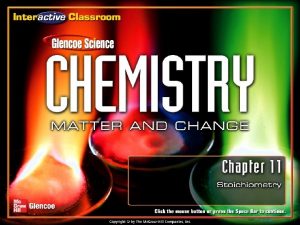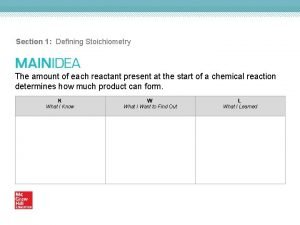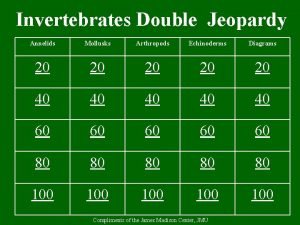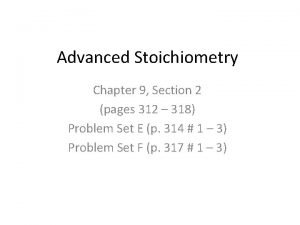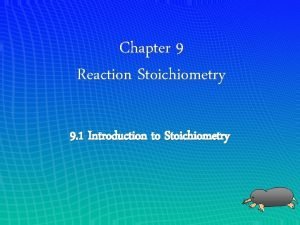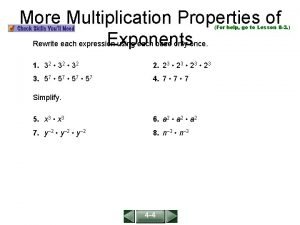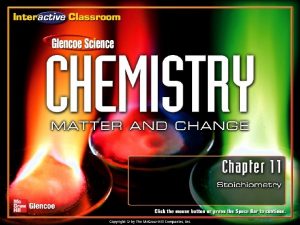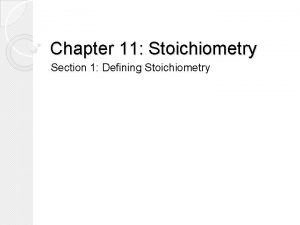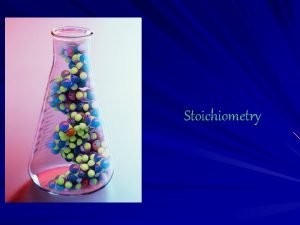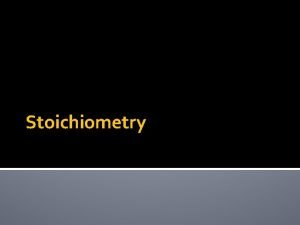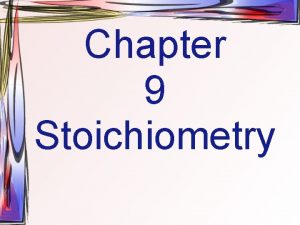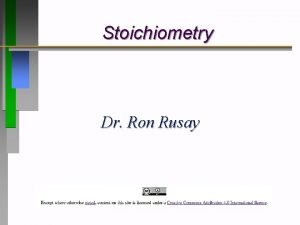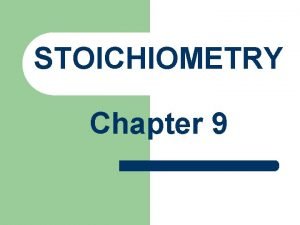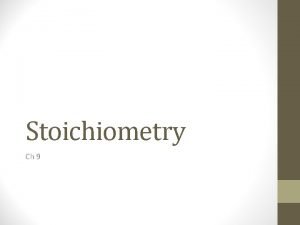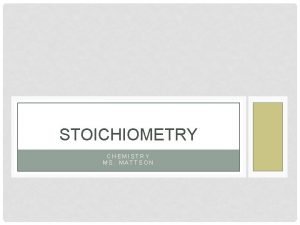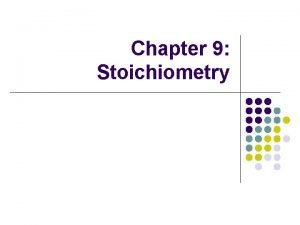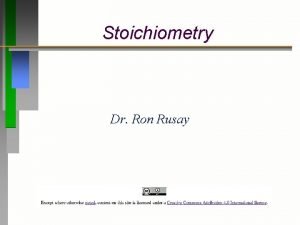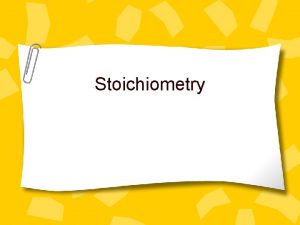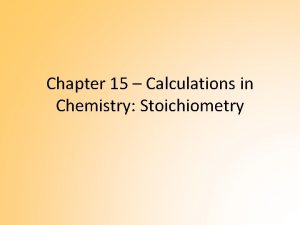Section 1 Defining Stoichiometry The amount of each












































- Slides: 44

Section 1: Defining Stoichiometry The amount of each reactant present at the start of a chemical reaction determines how much product can form. K What I Know W What I Want to Find Out L What I Learned

Essential Questions • Which relationships can be derived from a balanced chemical equation? • How are mole ratios written from a balanced chemical equation? Copyright © Mc. Graw-Hill Education Defining Stoichiometry

Vocabulary Review New • reactant • stoichiometry • mole ratio Copyright © Mc. Graw-Hill Education Defining Stoichiometry

Particle and Mole Relationships • Chemical reactions stop when one of the reactants is used up. • Stoichiometry is the study of quantitative relationships between the amounts of reactants used and amounts of products formed by a chemical reaction. • Stoichiometry is based on the law of conservation of mass. • The mass of reactants equals the mass of the products. Copyright © Mc. Graw-Hill Education Defining Stoichiometry

INTERPRETING CHEMICAL EQUATIONS Use with Example Problem 1. KNOWN UNKNOWN Problem C 3 H 8(g) + 5 O 2(g) → 3 CO 2(g) + 4 H 2 O(g) Equation interpreted in terms of molecules = ? The combustion of propane (C 3 H 8) provides energy for heating homes, cooking food, and soldering metal parts. Interpret the equation for the combustion of propane in terms of representative particles, moles, and mass. Show that the law of conservation of mass is observed. Response ANALYZE THE PROBLEM The coefficients in the balanced chemical equation shown below represent both moles and representative particles, in this case molecules. Therefore, the equation can be interpreted in terms of molecules and moles. The law of conservation of mass will be verified if the masses of the reactants and products are equal. Copyright © Mc. Graw-Hill Education Equation interpreted in terms of moles = ? Equation interpreted in terms of mass = ? SOLVE FOR THE UNKNOWN The coefficients in the chemical equation indicate the number of molecules. 1 molecule C 3 H 8 + 5 molecules O 2 → 3 molecules CO 2 + 4 molecules H 2 O The coefficients in the chemical equation also indicate the number of moles. 1 mol C 3 H 8 + 5 mol O 2 → 3 mol CO 2 + 4 mol H 2 O Defining Stoichiometry

INTERPRETING CHEMICAL EQUATIONS EVALUATE THE ANSWER The sums of the reactants and the products are correctly stated to the first decimal place because each mass is accurate to the first decimal place. The mass of reactants equals the mass of products, as predicted by the law of conservation of mass. Copyright © Mc. Graw-Hill Education Defining Stoichiometry

Particle and Mole Relationships • A mole ratio is a ratio between the numbers of moles of any two substances in a balanced equation. • The number of mole ratios that can be written for any equation is (n)(n – 1) where n is the number of species in the chemical reaction. Copyright © Mc. Graw-Hill Education Defining Stoichiometry

Practice Problems • Each table will act as a group of 4 • Grab a worksheet • Each group member is to do one of the following problems: – #1 (b and c) on page 371 – #3 (b and c) on page 372

Using Stoichiometry • All stoichiometric calculations begin with a balanced chemical equation. 4 Fe(s) + 3 O 2(g) → 2 Fe 2 O 3(s) • Steps to solve mole-to-mole, mole-to-mass, and mass-to-mass stoichiometric problems: 1. Write a balanced chemical equation for the reaction. 2. Determine where to start your calculations by noting the unit of the given substance. • If mass (in grams) of the given substance is the starting unit, you must convert to moles. • If amount (in moles) of the given substance is the starting unit, convert moles of the given substance to moles of the unknown. Copyright © Mc. Graw-Hill Education Stoichiometric Calculations

Using Stoichiometry 3. The end point of the calculation depends on the desired unit of the unknown substance. • If the answer must be in moles, stop you are finished. • If the answer must be in grams, convert moles of unknown to grams of unknown using the molar mass as the conversion factor. • Example: The carbon dioxide exhaled by astronauts can be removed from a spacecraft by reacting with lithium hydroxide as follows: • CO 2(g) + Li. OH(s) → Li 2 CO 3(s) + H 2 O • An average person exhales about 20 moles of CO 2 per day. How many moles of Li. OH would be required to maintain 2 astronauts in a spacecraft for three days? Copyright © Mc. Graw-Hill Education Stoichiometric Calculations

Using Stoichiometry 1. Balance equation: CO 2 + 2 Li. OH → Li 2 CO 3 + H 2 O 2. Determine moles of given substance: 20 moles person, 2 people = 40 moles x 3 days = 120 moles of CO 2 3. Convert moles of given substance to moles of unknown: 120 mol CO 2 x 2 mol/1 mol = 240 moles of Li. OH Copyright © Mc. Graw-Hill Education Stoichiometric Calculations

MOLE-TO-MOLE STOICHIOMETRY Use with Example Problem 2. Problem One disadvantage of burning propane (C 3 H 8) is that carbon dioxide (CO 2) is one of the products. The released carbon dioxide increases the concentration of CO 2 in the atmosphere. How many moles of CO 2 are produced when 10. 0 mol of C 3 H 8 are burned in excess oxygen in a gas grill? KNOWN UNKNOWN moles C 3 H 8 = 10. 0 mol C 3 H 8 moles CO 2 = ? mol CO 2 Response ANALYZE THE PROBLEM You are given moles of the reactant, C 3 H 8 and must find the moles of the product, CO 2. First write the balanced chemical equation, then convert from moles of C 3 H 8 to moles of CO 2. The correct mole ratio has moles of unknown substance in the numerator and moles of known substance in the denominator. Copyright © Mc. Graw-Hill Education Stoichiometric Calculations

MOLE-TO-MASS STOICHIOMETRY Use with Example Problem 3. Problem Determine the mass of sodium chloride (Na. Cl), commonly called table salt, produced when 1. 25 mol of chlorine gas (Cl 2) reacts vigorously with excess sodium. Response KNOWN UNKNOWN moles of chlorine = 1. 25 mol Cl 2 mass of sodium chloride = ? g Na. Cl ANALYZE THE PROBLEM You are given the moles of the reactant, Cl 2, and must determine the mass of the product, Na. Cl. You must convert from moles of Cl 2 to moles of Na. Cl using the mole ratio from the equation. Then, you need to convert moles of Na. Cl to grams of Na. Cl using the molar mass as the conversion factor. Copyright © Mc. Graw-Hill Education Stoichiometric Calculations

MOLE-TO-MASS STOICHIOMETRY Copyright © Mc. Graw-Hill Education EVALUATE THE ANSWER Because the given number of moles has three significant figures, the mass of Na. Cl also has three. To quickly assess whether the calculated mass value for Na. Cl is correct, perform the calculations in reverse: divide the mass of Na. Cl by the molar mass of Na. Cl, and then divide the result by 2. You will obtain the given number of moles of Cl 2. Stoichiometric Calculations

MASS-TO-MASS STOICHIOMETRY Use with Example Problem 4. Problem Ammonium nitrate (NH 4 NO 3), an important fertilizer, produces dinitrogen monoxide (N 2 O) gas and H 2 O when it decomposes. Determine the mass of H 2 O produced from the decomposition of 25. 0 g of solid NH 4 NO 3. KNOWN UNKNOWN mass of ammonium nitrate = 25. 0 g NH 4 NO 3 mass of water = ? g H 2 O Response ANALYZE THE PROBLEM You are given a description of the chemical reaction and the mass of the reactant. You need to write the balanced chemical equation and convert the known mass of the reactant to moles of the reactant. Then, use a mole ratio to relate moles of the reactant to moles of the product. Finally, use the molar mass to convert from moles of the product to the mass of the product. Copyright © Mc. Graw-Hill Education Stoichiometric Calculations

MASS-TO-MASS STOICHIOMETRY Copyright © Mc. Graw-Hill Education EVALUATE THE ANSWER The number of significant figures in the answer, three, is determined by the given grams of NH 4 NO 3. To verify that the mass of H 2 O is correct, perform the calculations in reverse. Stoichiometric Calculations

Section 3: Limiting Reactants A chemical reaction stops when one of the reactants is used up. K What I Know W What I Want to Find Out L What I Learned

Why do reactions stop? • Reactions proceed until one of the reactants is used up and one is left in excess. • The limiting reactant limits the extent of the reaction and, thereby, determines the amount of product formed. • The excess reactants are all the leftover unused reactants. Copyright © Mc. Graw-Hill Education Limiting Reactants

Why do reactions stop? • Determining the limiting reactant is important because the amount of the product formed depends on this reactant. Copyright © Mc. Graw-Hill Education Limiting Reactants

Calculating the Product when a Reactant is Limiting • Example: S 8(l) + 4 Cl 2(g) → 4 S 2 Cl 2(l) If 200. 0 g of sulfur reacts with 100. 0 g of chlorine, what mass of disulfur dichloride is produced? 1. Determine moles of reactants Copyright © Mc. Graw-Hill Education Limiting Reactants

Calculating the Product when a Reactant is Limiting 2. Determine whether the two reactants are in the correct mole ratio, as given in the balanced chemical equation. Only 1. 808 mol of chlorine is available for every 1 mol sulfur, instead of the 4 mol of chlorine required by the balanced chemical equation, thus chlorine is the limiting reactant. Copyright © Mc. Graw-Hill Education Limiting Reactants

Calculating the Product when a Reactant is Limiting 3. Calculate the amount of product formed. Copyright © Mc. Graw-Hill Education Limiting Reactants

Calculating the Product when a Reactant is Limiting • Now that you have determined the limiting reactant and the amount of product formed, what about the excess reactant, sulfur? How much of it reacted? 1. You need to make a mole-to-mass calculation to determine the mass of sulfur needed to react completely with 1. 410 mol of chlorine. Copyright © Mc. Graw-Hill Education Limiting Reactants

Calculating the Product when a Reactant is Limiting 2. Next, obtain the mass of sulfur needed: 3. Knowing that 200. 0 g of sulfur is available and only 90. 42 g is needed, you can calculate the amount of sulfur left unreacted when the reaction ends. • Using an excess reactant can speed up the reaction. • Using an excess reactant can drive a reaction to completion. Copyright © Mc. Graw-Hill Education Limiting Reactants

DETERMINING THE LIMITING REACTANT Use with Example Problem 5. Problem The reaction between solid white phosphorus (P 4) and oxygen produces solid tetraphosphorus decoxide (P 4 O 10). This compound is often called diphosphorus pentoxide because its empirical formula is P 2 O 5. a. Determine the mass of P 4 O 10 formed if 25. 0 g of P 4 and 50. 0 g of oxygen are combined. b. How much of the excess reactant remains after the reaction stops? Copyright © Mc. Graw-Hill Education Response ANALYZE THE PROBLEM You are given the masses of both reactants, so you must identify the limiting reactant and use it to find the mass of the product. From moles of the limiting reactant, the moles of the excess reactant used in the reaction can be determined. The number of moles of the excess reactant that reacted can be converted to mass and subtracted from the given mass to find the amount in excess. KNOWN UNKNOWN mass of phosphorus = 25. 0 g P 4 mass of tetraphosphorus decoxide = ? g P 4 O 10 mass of oxygen = 50. 0 g O 2 mass of excess reactant = ? g excess reactant Limiting Reactants

DETERMINING THE LIMITING REACTANT SOLVE FOR THE UNKNOWN Determine the limiting reactant. • Write the balanced chemical equation, and identify the known and the unknown. 25. 0 g 50. 0 g ? g P 4(s) + 5 O 2(g) → P 4 O 10(s) Determine the number of moles of the reactants by multiplying each mass by the conversion factor that relates moles and mass—the inverse of molar mass. Copyright © Mc. Graw-Hill Education Limiting Reactants

DETERMINING THE LIMITING REACTANT Copyright © Mc. Graw-Hill Education Limiting Reactants

DETERMINING THE LIMITING REACTANT • Subtract the mass of O 2 used from the mass available. 50. 0 g O 2 available - 32. 3 g O 2 consumed = 17. 7 g O 2 in excess EVALUATE THE ANSWER All values have a minimum of three significant figures, so the mass of P 4 O 10 is correctly stated with three digits. The mass of excess O 2 (17. 7 g) is found by subtracting two numbers that are accurate to the first decimal place. Therefore, the mass of excess O 2 correctly shows one decimal place. The sum of the O 2 that was consumed (32. 3 g) and the given mass of P 4 (25. 0 g) is 57. 3 g, the calculated mass of the product P 4 O 10. Copyright © Mc. Graw-Hill Education Limiting Reactants

Professor Dave Link • https: //www. youtube. com/watch? v=dodsv. Tfq WNc

How Much Product? • Laboratory reactions do not always produce the calculated amount of products. • Reactants stick to containers. • Competing reactions form other products. Copyright © Mc. Graw-Hill Education Percent Yield

How Much Product? • The theoretical yield is the maximum amount of product that can be produced from a given amount of reactant. • The actual yield is the amount of product actually produced when the chemical reaction is carried out in an experiment. • The percent yield of a product is the ratio of the actual yield expressed as a percent. Copyright © Mc. Graw-Hill Education Percent Yield

PERCENT YIELD Use with Example Problem 6. Problem Solid silver chromate (Ag 2 Cr. O 4) forms when excess potassium chromate (K 2 Cr. O 4) is added to a solution containing 0. 500 g of silver nitrate (Ag. NO 3). Determine theoretical yield of Ag 2 Cr. O 4. Calculate the percent yield if the reaction yields 0. 455 g of Ag 2 Cr. O 4. KNOWN UNKNOWN mass of silver nitrate = 0. 500 g Ag. NO 3 theoretical yield = ? g Ag 2 Cr. O 4 actual yield = 0. 455 g Ag 2 Cr. O 4 percent yield = ? % Ag 2 Cr. O 4 Response ANALYZE THE PROBLEM You know the mass of a reactant and the actual yield of the product. Write the balanced chemical equation, and calculate theoretical yield by converting grams of Ag. NO 3 to moles of Ag. NO 3, moles of Ag. NO 3 to moles of Ag 2 Cr. O 4, and moles of Ag 2 Cr. O 4 to grams of Ag 2 Cr. O 4. Calculate the percent yield from the actual yield and theoretical yield. Copyright © Mc. Graw-Hill Education Percent Yield

PERCENT YIELD Copyright © Mc. Graw-Hill Education EVALUATE THE ANSWER The quantity with the fewest significant figures has three, so the percent is correctly stated with three digits. The molar mass of Ag 2 Cr. O 4 is about twice the molar mass of Ag. NO 3, and the ratio of moles of Ag. NO 3 to moles of Ag 2 Cr. O 4 in the equation is 2: 1. Therefore, 0. 500 g of Ag. NO 3 should produce about the same mass of Ag 2 Cr. O 4. The actual yield of Ag 2 Cr. O 4 is close to 0. 500 g, so a percent yield of 93. 2% is reasonable. Percent Yield

Percent Yield in the Marketplace • Percent yield is important in the cost effectiveness of many industrial manufacturing processes. Copyright © Mc. Graw-Hill Education Percent Yield

Quiz • 1. What is the maximum amount of product that can be produced from a given amount of reactant? a) percent yield b) theoretical yield c) actual yield d) mole ratio

• 1. What is the maximum amount of product that can be produced from a given amount of reactant? a) percent yield b) theoretical yield c) actual yield d) mole ratio

• 2. The reaction of 5. 0 grams of fluorine with excess chlorine produced 5. 6 grams of Cl. F 3. What percent yield of Cl. F 3 was obtained? Cl 2 + 3 F 2 → 2 Cl. F 3 A. B. C. D. 0. 58 0. 69 0. 76 0. 86

• 2. The reaction of 5. 0 grams of fluorine with excess chlorine produced 5. 6 grams of Cl. F 3. What percent yield of Cl. F 3 was obtained? Cl 2 + 3 F 2 → 2 Cl. F 3 A. B. C. D. 0. 58 0. 69 0. 76 0. 86

• 3. In the bunsen burner reaction of methane and oxygen, what is the percent yield if 64. 0 g of methane yields 95. 1 grams of carbon dioxide? CH 4(g) + 2 O 2(g) → CO 2(g) + 2 H 2 O(g) A. B. C. D. 0. 46 0. 54 1. 49 0. 5

• 3. In the bunsen burner reaction of methane and oxygen, what is the percent yield if 64. 0 g of methane yields 95. 1 grams of carbon dioxide? CH 4(g) + 2 O 2(g) → CO 2(g) + 2 H 2 O(g) A. B. C. D. 0. 46 0. 54 1. 49 0. 5

• 4. Percent yield can never be greater than ____. A. theoretical yield B. 100% C. both a and b D. 50%

• 4. Percent yield can never be greater than ____. A. theoretical yield B. 100% C. both a and b D. 50%

• 5. The statement that percent yield can never be greater than theoretical yield is another example of the ____. A. ideal gas law B. law of conservation of mass C. law of conservation of momentum D. law of conservation of energy

• 5. The statement that percent yield can never be greater than theoretical yield is another example of the ____. A. ideal gas law B. law of conservation of mass C. law of conservation of momentum D. law of conservation of energy
 Defining and non defining sentences
Defining and non defining sentences Relative clauses defining and non defining
Relative clauses defining and non defining Defining and non defining relative clauses
Defining and non defining relative clauses Defining and non defining relative clauses in telugu
Defining and non defining relative clauses in telugu Relative clauses örnekleri
Relative clauses örnekleri Non defining relatives clauses
Non defining relatives clauses Defining stoichiometry
Defining stoichiometry Defining stoichiometry worksheet answers
Defining stoichiometry worksheet answers Jeopardy
Jeopardy How to write 10 centavos
How to write 10 centavos The structure of the atom section 2 defining the atom
The structure of the atom section 2 defining the atom Chemistry chapter 9 stoichiometry
Chemistry chapter 9 stoichiometry Percentage yield
Percentage yield Chapter 9 section 3 stoichiometry
Chapter 9 section 3 stoichiometry Stoichiometry introduction
Stoichiometry introduction 7-3 more multiplication properties of exponents
7-3 more multiplication properties of exponents Identify each line or segment that intersects each circle
Identify each line or segment that intersects each circle Hát kết hợp bộ gõ cơ thể
Hát kết hợp bộ gõ cơ thể Lp html
Lp html Bổ thể
Bổ thể Tỉ lệ cơ thể trẻ em
Tỉ lệ cơ thể trẻ em Voi kéo gỗ như thế nào
Voi kéo gỗ như thế nào Thang điểm glasgow
Thang điểm glasgow Chúa sống lại
Chúa sống lại Các môn thể thao bắt đầu bằng tiếng bóng
Các môn thể thao bắt đầu bằng tiếng bóng Thế nào là hệ số cao nhất
Thế nào là hệ số cao nhất Các châu lục và đại dương trên thế giới
Các châu lục và đại dương trên thế giới Công thức tính thế năng
Công thức tính thế năng Trời xanh đây là của chúng ta thể thơ
Trời xanh đây là của chúng ta thể thơ Mật thư tọa độ 5x5
Mật thư tọa độ 5x5 101012 bằng
101012 bằng Phản ứng thế ankan
Phản ứng thế ankan Các châu lục và đại dương trên thế giới
Các châu lục và đại dương trên thế giới Thơ thất ngôn tứ tuyệt đường luật
Thơ thất ngôn tứ tuyệt đường luật Quá trình desamine hóa có thể tạo ra
Quá trình desamine hóa có thể tạo ra Một số thể thơ truyền thống
Một số thể thơ truyền thống Cái miệng nó xinh thế
Cái miệng nó xinh thế Vẽ hình chiếu vuông góc của vật thể sau
Vẽ hình chiếu vuông góc của vật thể sau Nguyên nhân của sự mỏi cơ sinh 8
Nguyên nhân của sự mỏi cơ sinh 8 đặc điểm cơ thể của người tối cổ
đặc điểm cơ thể của người tối cổ Ví dụ về giọng cùng tên
Ví dụ về giọng cùng tên Vẽ hình chiếu đứng bằng cạnh của vật thể
Vẽ hình chiếu đứng bằng cạnh của vật thể Tia chieu sa te
Tia chieu sa te Thẻ vin
Thẻ vin đại từ thay thế
đại từ thay thế






